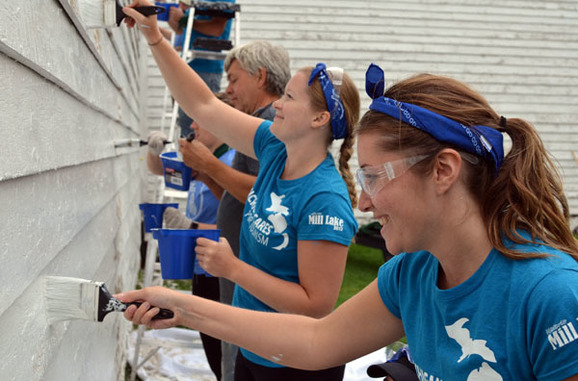
By JOHN PEPIN
Michigan Department of Natural Resources
 Not long
after the early morning sunlight broke Monday over the gray-shingled roofs at
Fort Wilkins Historic State Park, the dizzying sounds of a swarm of activity
began to fill the skies from behind the pointed stockade fence.
Hammers
rang. Power drills whirred. There were also the soft, wispy sounds of paint
brushes being pushed and pulled over wood-plank surfaces. There was activity everywhere.
Amid it
all were the voices of the young and old – talking, sharing instruction,
support and laughs – because at the heart of all this effort were people.
These individuals,
from cities and towns across the state, passionate and kind, made up a powerful
all-volunteer workforce nearly 160 strong.
They assembled
for a couple of days near the tip of the Keweenaw Peninsula under a single
banner proclaiming “Michigan Cares for Tourism.”
|
 Beginnings
“We
started the program in 2012, partnering with the Michigan Department of Natural
Resources and Travel Michigan, Indian Trails, Grand Valley State University, an
organization called Tourism Cares that did similar events on a national level
and a marketing company by the name of Driven,” said Patty Janes, volunteer
coordinator for Michigan Cares for Tourism and a professor of hospitality and
tourism management at Grand Valley State University.
“So, the
six of us came together and said, ‘Could we bring the tourism industry together
to donate time, resources and effort to help restore our historic attractions
in Michigan,’ knowing full well that the 260 (attractions) that the state
managed, for an example, had a maintenance deficit in the millions of dollars?”
The
answer was “yes.”
Over the
past six years, the organization has empowered 2,365 volunteers over 10
projects, including seven multiple-day efforts.
This
week’s work at Fort Wilkins was backed by the in-kind and financial
contributions of more than 60 businesses and organizations.
“It’s a
zero-base budget project. We don’t have money,” Janes said. “The only way the
projects work is if the industry cares.”
|
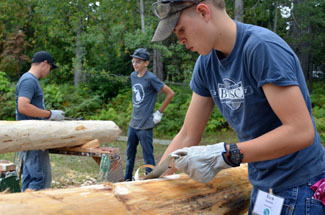 A board
of 20 organizes the group’s projects, taking on one each autumn. The group has
previously worked in the Upper Peninsula at Fayette Historic State Park in
Delta County.
Personal contributions
At Fort
Wilkins, some of the volunteers drove 12 hours to get there. Seventy came on
Indian Trails buses from Grand Rapids and Detroit. The other 90 traveled on
their own. They averaged four nights spent in the region.
Ezra
Swanson drove up to Copper Harbor with his dad and his sister from Shelby in
the western part of the Lower Peninsula. Swanson is 16 and his sister is 18.
“I think
it’s pretty cool. It’s a pretty good thing to do. It’s pretty neat,” Swanson
said, who was participating in his first volunteer effort with the
organization. “Especially, I love history so it’s nice to see that people are
still taking care of that, trying to preserve history.”
In the
morning, he was involved in rebuilding the stockade fence. Afternoon found him
standing in a pile of wood shavings, helping to strip bark from logs for new
posts.
Swanson
said he would recommend the organization to others.
“It’s
nice to be working with your hands,” he said. “I grew up on a farm, so I work
with my hands a lot, but it’s nice to be doing more of that, meeting other
people, more Michiganders, more Wolverines, so it’s nice to do that too.”
Corrina
Kostrzewa,
19, of Jackson is in her third year studying at Michigan Tech in Houghton. She
came to Fort Wilkins to volunteer with her dad.
|
 “I just
heard about it through my dad, and he’s done it for multiple years and so I
figured I’d want to join,” she said. “And since coming up to Michigan Tech, the
U.P. has become my home. So, anything I can do to restore a historic site in
the area, that’s pretty awesome.”
Corrina’s
dad, Mark Kostrzewa, works as a front desk manager at the FireKeepers Casino
Hotel in Battle Creek.
“This is
my fifth event with Michigan Cares,” he said.
He has
helped pour concrete and paint at a picnic shelter at Belle Isle Park, cleared
brush and helped remove invasive plant species near Roscommon, and shoveled and
hauled limestone to help lay a pathway in Saugatuck.
He first
heard about Michigan Cares for Tourism years ago when one of his work
colleagues went to the governor’s conference on Mackinac Island and heard about
it.
“We
signed up the first year, and we’ve been doing it ever since,” he said. “This
year, FireKeepers has four people here. So, we’ve been slowly growing the group
that we bring because we think it’s a great effort.
“I think
it’s great that we leave something behind.”
At Fort
Wilkins, crew leaders were hoping a stockade fence would be finished by the end
of the day. Instead, the crew came within four or five posts of finishing the
work by lunchtime.
“Because
it takes so much to take care of these facilities and the DNR has a lot on
their hands, I know myself, I think everybody else takes pride in the ability
to come and give back to areas that matter to Michigan,” Kostrzewa said.
|
 A third of
the volunteers had to take a day off work to come to Fort Wilkins.
More than
half had to pay for housing or other items out of their own pockets to
volunteer. A $50 fee is paid to reserve a spot on the volunteer roster, with
that money used to buy T-shirts and other items of appreciation given back to
the workers.
“That’s
been the fascinating model for me. People just give, and when people are giving
like that, how does that not become the perfect world?” Janes asked,
rhetorically. “They’re giving for something bigger than themselves, and they
are spending their time to come all this way to give to others.”
More benefits
Though
the cultural-historical impact is the mainstay of the Michigan Cares for
Tourism effort, there are additional benefits realized.
Volunteers
have a fun and enriching experience, networking together while they work, which
can aid in development of other projects and other efforts taking place with
other organizations across the state.
They also
gain first-hand knowledge about Michigan’s historic and cultural attractions.
Kyle
Loup, a park ranger at Van Riper State Park, was working as a foreman in charge
of a staining project, leading a crew of seven, enjoying his first opportunity
to volunteer with the group.
|
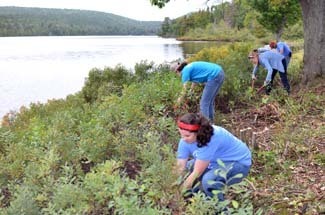 He
started working for the DNR as a summer ranger at Fayette Historic State Park.
He loves history.
“With the
history and the tourism, that sparked my interest,” he said. “It was five
summers at Fayette, so to come up here kind of brings back memories.
“In
general, this is a great experience because, just for the fact that you get to
meet a lot of different people, (who) come from different cultures, all
different backgrounds and all areas of the state.”
The group’s
stay has an economic impact on the local community, and the work to improve the
park will help increase the number of annual visitors, which feeds back into
the community’s economic good fortune.
Doug
Rich, western U.P. district supervisor for the DNR’s Parks
and Recreation Division, said local business folks are aware Fort Wilkins
is the iconic attraction bringing visitors to Copper Harbor.
|
“If we
improve this, it improves the entire business climate of the community because
it’s all connected,” Rich said. “It doesn’t matter who you are, we’re all one
big team.”
Proof in the pudding
Bob Wild,
acting park supervisor at Fort Wilkins Historic State Park, said Monday’s work
at the fort was his first involvement with the organization. He called it a “pretty
amazing effort.”
“They’re
accomplishing everything from redoing our ADA-accessible paths to helping to
paint some of the toilet-restroom buildings in the campground. A lot of the
focus is on the historic fort complex,” Wild said. “We’re painting exterior
walls, we’re painting interior, re-decking, replacing stockage walls, we’ve got
crews out doing trail restoration work, lots of trimming work going on, there’s
a lot of projects going, replacing picnic tables and park bench boards, a lot
of crews out there working various different projects.”
Wild, who
has worked as a park interpreter at Porcupine Mountains Wilderness State Park –
Michigan’s largest state park – said the volunteer effort fills a distinct
need, important to any park.
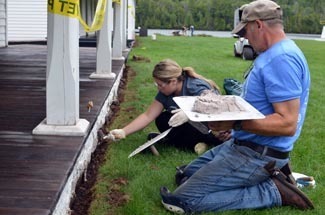 “It’s a
lot of work that’s really difficult for park staff to get to because a lot of
this kind of work requires a lengthy period of time where you can have
uninterrupted, focused work,” he said. “There’s going to be 1,000 hours with
all these people working a full day’s shift of uninterrupted, focused work.
“It’s a
huge time saver for the park and a great benefit for the park and the public
who are going to come here and see the results of all this work.”
Barry James,
a historian at Fort Wilkins, agreed.
“Through
the (DNR) Parks and Recreation Division and the Michigan History Center, we
established a priority list of projects to be done by Michigan Cares for
Tourism here at Fort Wilkins, and we were able to come up with 23 projects that
we thought could be completed during their six to seven volunteer hours in one
day at the fort,” James said.
“They’ve
been able to get to some projects that have been on a to-do list for several
years. So, to have this amount of volunteer labor and to be able to get to some
projects that probably wouldn’t have been reached or gotten to in several years
is great, not only for the site, but for the preservation of the buildings and
to prepare and move on for the future.”
James
said the work involved “primarily routine maintenance projects, like painting
and clearing brush through view sheds, historic view sheds, to open those up
for the public to be able to see vistas that the soldiers and miners saw almost
175 years ago.”
Rich said
park staffers who may have initially been skeptical of what the effort might
produce, at the cost of a lot of preparation for the visit, were converted,
having seen the “proof is in the pudding.”
|
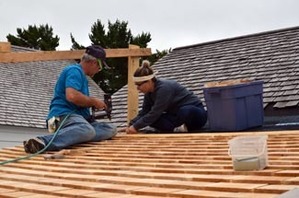 Rich said
he had seen it before and came to Fort Wilkins a supporter of the group.
“It’s
just amazing how much work, how much excitement is involved with it,” he said.
Janes
said she got goosebumps when a ranger who has worked at the park for 42 years told
her staffers there never would have been able to find the time to accomplish
these projects.
“That’s
what the industry wants to know, that we did something that just wasn’t ‘you’re
going to get it done next week and you’re just having us do it,’” she said. “No,
this is stuff that adds value and visitors have a better experience (and) our
industry is better educated. I call it the perfect educational model.”
Going green
While the
volunteers worked, another effort was under way all around them, one that benefitted
the project from an environmental perspective.
Jessica
Loding, director of events and strategic partnerships for Schupan Events
Recycling of Kalamazoo, was working to help the volunteers reduce their
environmental impact.
“We
provide sustainability services for carbon off-setting, recycling, food
composting and waste diversion for Michigan Cares for Tourism,” Loding said.
Her job
is to help the group recycle, use and compost what they can and then send the
rest to the landfill.
|
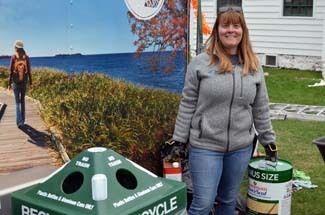 “Last
year, in Roscommon, we had a 74 percent diversion rate, meaning 74 percent of
all the material generated from the event was diverted from the landfill
through recycling or reuse programs,” Loding said. “…We like to minimize our
environmental impact on the areas in which we travel to restore for the DNR and
the state and things like that, and so we’re just trying to do our little
part.”
Loding
runs the sustainability division at her company, which has about 80 clients in
Michigan. She works with events, entertainment venues, communities and within
the tourism industry to make things green.
NASCAR
events in Michigan and the Detroit International Jazz Festival are two
examples.
The Fort
Wilkins work bee resulted in a 63 percent diversion rate, with a 67 percent
rate over the past two Michigan Cares for Tourism events.
“We had
about 70-75 people take the bus up here from Grand Rapids and Detroit, and as a
result of not having them bring their cars up here, it off-set about 36,000
pounds of CO2 (carbon dioxide),” she said.
Looking ahead
Next
fall, Michigan Cares for Tourism will travel to Leelanau State Park and the
Grand Traverse Lighthouse to help make operations there run solely on solar
power.
“People
are working so hard,” Janes said, looking at volunteers clearing brush along
the shore of Lake Fanny Hooe at the fort. “These people run their own
businesses, they are hard-working, super-passionate. We get the best of the
best that come because they’re willing to invest all that time.
“I am
very proud of our industry, very proud of these folks and all the people that
have come before them – thousands now – to make a difference. You can choose a
lot of other ways to spend your day.”
To find out more about Michigan Cares for Tourism, visit michigancares4tourism.com/
Check out
previous Showcasing the DNR stories in our archive at michigan.gov/dnrstories.
To subscribe to upcoming Showcasing articles sign-up for free email delivery at
michigan.gov/dnr.
|
/Note to editors: Media contact: John Pepin, 906-226-1352. Accompanying photos and a text-only version of this story are available below for download. Caption information follows. Credit Michigan Department of Natural Resources, unless otherwise noted.
Text-only
version of this story.
Brush: Volunteers clear brush
from along the shore at Lake Fanny Hooe at Fort Wilkins Historic State Park in
Copper Harbor.
Drill: Holes are drilled in
the ends of park bench boards at Fort Wilkins.
Grass: A volunteer pulls
grass and weeds away from the front porch of one of the buildings at Fort
Wilkins.
Log: Mark and Corrina
Kostrzewa of Jackson work on preparing a fence post for the stockade at Fort Wilkins.
Lunch:
Some
of the 159 Michigan Cares for Tourism volunteers enjoying lunch at Fort Wilkins
Historic State Park in Copper Harbor.
Paint: Several volunteers
team up to paint the side of a building at Fort Wilkins.
Peel: Ezra Swanson of Shelby
peels and strips bark from a log that will soon become a fence post.
Porch: Two Michigan Cares for
Tourism volunteers work to repair a porch at Fort Wilkins.
Resurfacing: Volunteers resurface a
path at Fort Wilkins Historic State Park in Copper Harbor.
Recycle: Jessica Loding,
director of events and strategic partnerships for Schupan Events Recycling of
Kalamazoo working to help reduce environmental impacts during Michigan Cares
for Tourism’s event at Fort Wilkins.
Rich-Janes: Doug Rich, western
U.P. district supervisor for the DNR’s Parks and Recreation Division, and Patty
Janes talk at Fort Wilkins this week.
Roof: Volunteers work on
resurfacing a roof at Fort Wilkins./
|